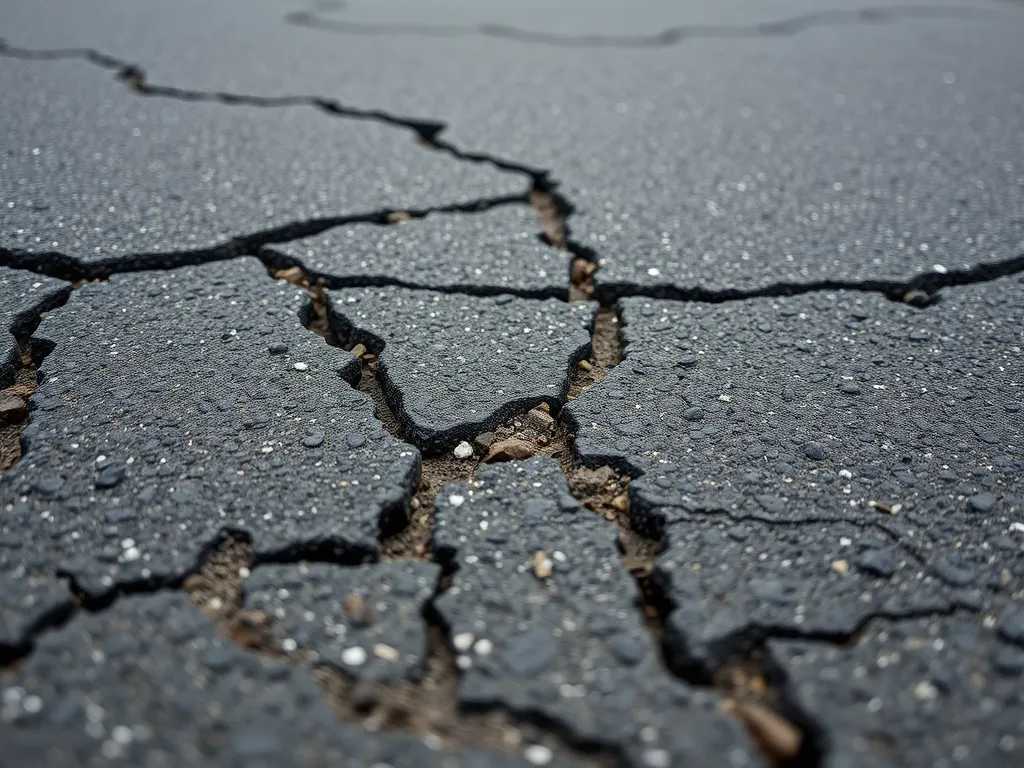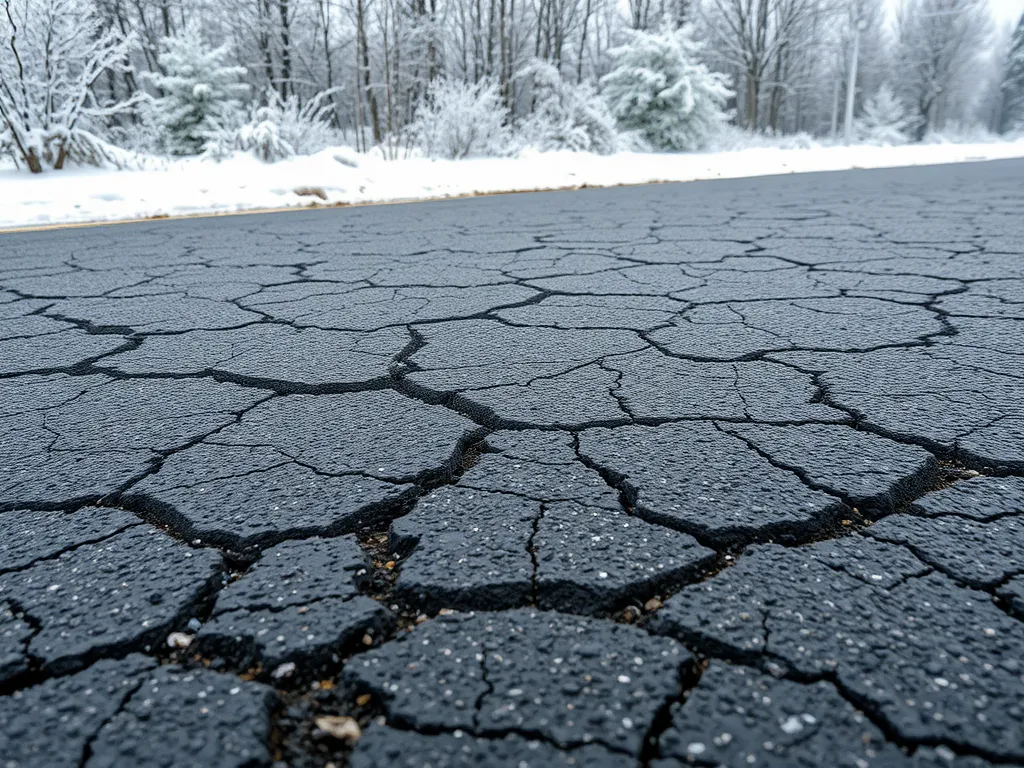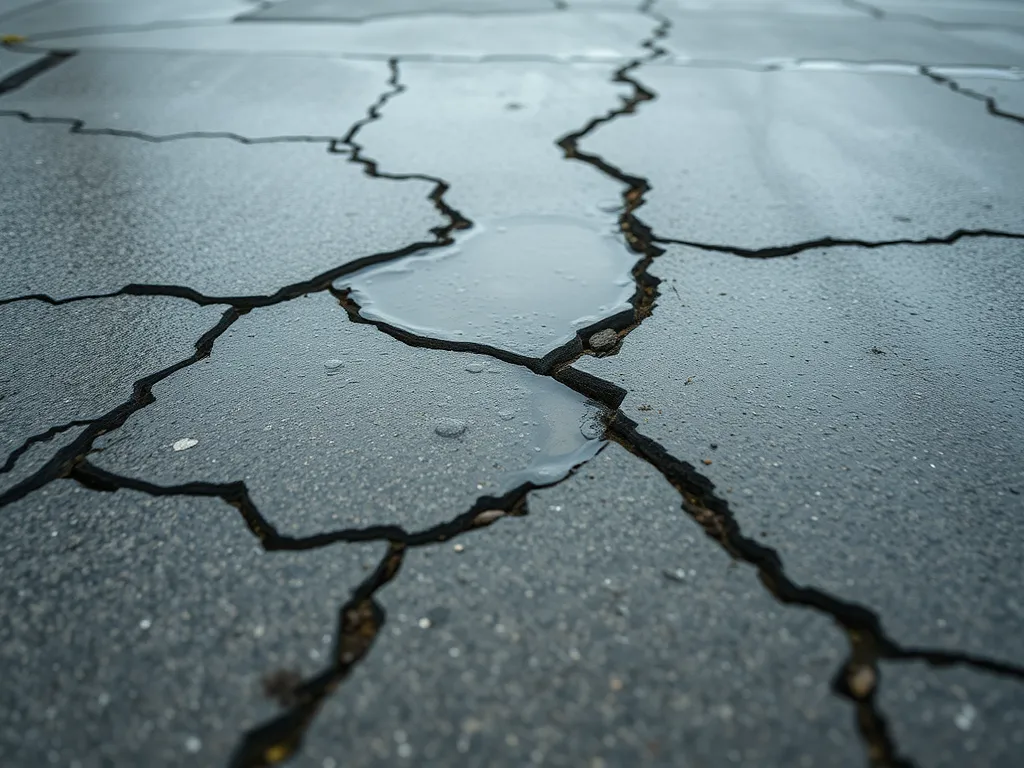Causes Of Asphalt Driveway Cracking: Key Factors and Prevention
Published on: April 18, 2025 | Last Updated: April 14, 2025
Written By: George Voss
Asphalt driveway cracking occurs when environmental stress, material flaws, or structural pressure damage the pavement’s surface and base layers. Common triggers include freeze-thaw cycles breaking apart weak spots, UV rays drying out the asphalt binder, poor compaction during installation, or heavy vehicles bending thin sections. Spotting early signs like hairline cracks, alligator patterns, or uneven surfaces helps homeowners address issues before repairs become costly.
This article breaks down why driveways crack and how to stop it. We’ll explore temperature swings, UV damage, subpar materials, and heavy vehicle impacts. You’ll also find actionable tips for sealing cracks, improving drainage, and choosing quality asphalt mixes rated for local climates. Learn which cracks need immediate fixes and how proper installation prevents 80% of common pavement failures.
Contents
Primary Causes Of Asphalt Driveway Cracking
Asphalt driveways face multiple threats that lead to cracks over time. These factors range from natural weather patterns to human errors during construction.
Environmental and Weather-related Factors
Weather plays a major role in asphalt pavement cracking causes. Extreme temperatures, sunlight, and moisture weaken the material’s structure.
Freeze-Thaw Cycles and Temperature Fluctuations
Water seeps into tiny pores during rain or snowmelt. When temperatures drop below 32°F, trapped water freezes and expands by 9%, pushing against the asphalt. Repeated cycles create cracks like alligatoring or linear splits.
UV Exposure and Asphalt Binder Degradation
Sunlight oxidizes the asphalt binder (bitumen), turning it brittle. Over 5–7 years, UV rays reduce flexibility by 40%, leading to surface raveling and cracks. Driveways in southern states like Arizona or Texas degrade faster due to intense sun exposure.
Thermal Expansion and Contraction
Asphalt expands under summer heat (up to 140°F surface temps) and contracts during winter. This movement creates stress fractures, especially near joints or edges. A 50°F temperature swing can cause up to 0.5 inches of lateral movement in a 20-foot driveway.
Material and Installation Issues
Faulty materials or rushed installations set the stage for premature asphalt driveway cracks. Quality matters from the ground up.
Poor Quality Asphalt Mix
Low-grade mixes lack proper ratios of aggregates, sand, and binder. For example, mixes with less than 5% bitumen by weight crack faster under load. Substandard PG (Performance Graded) binders rated below PG 64-22 fail to withstand temperature extremes.
Inadequate Base Compaction During Installation
A poorly compacted base layer (crushed stone or gravel) settles unevenly. Proper compaction requires 95% density tested with a nuclear gauge. Skipping this step leads to potholes and cracks within 12–18 months.
Thin Asphalt Layers
Driveways thinner than 2.5 inches lack structural strength. Heavy vehicles exert up to 100 PSI on surfaces, causing rutting and cracks. Residential driveways need at least 3 inches of asphalt over a 6-inch granular base for longevity.
Structural Stress Factors
External forces and ground instability amplify cracking risks. Even robust driveways have limits.
Heavy Vehicle Loads and Weight Stress
Frequent use by trucks over 10,000 lbs exceeds standard load capacity. A single-axle dump truck applies 3x more pressure than a passenger car, triggering fatigue cracks. Repeated stress concentrates along edges or the centerline, leading to “why do asphalt driveways crack down the middle” scenarios.
Soil Shifting or Settlement Under the Driveway
Expansive clay soils swell with moisture and shrink during droughts, moving up to 4 inches annually. Poorly compacted fill dirt or tree roots growing beneath the driveway also create voids, causing block or transverse cracks.
While these primary factors explain most asphalt driveway cracking reasons, secondary elements like drainage flaws or neglected repairs accelerate damage. Next, we’ll examine how water and maintenance habits worsen existing issues.
Secondary Contributing Factors
While main causes like weather and poor install drive cracks, other issues speed up damage. Let’s break down two key players: water and upkeep gaps.
Water Damage and Drainage Problems
Water weakens asphalt fast. Without proper flow, it eats at the base and top layers.
Pooling Water and Poor Drainage Design
Puddles that stay more than 24 hours spell trouble. They seep into tiny pores, soften the base, and split the surface. Driveways need a 2% slope (1/4 inch per foot) to push water off. Flat spots or wrong slope grades let water pool and chew through layers.
Edge Cracks Due to Erosion
Runoff strips soil from driveway edges. This leaves asphalt unsupported, causing lines along sides. Gravel loss near edges worsens it. Catch basins or French drains fix this by guiding water away.
Lack Of Maintenance
Asphalt needs care to fight wear. Skip steps, and small flaws grow fast.
Unsealed Surfaces Allowing Moisture Penetration
Fresh asphalt should be sealed in 6-12 months. Reapply sealcoat every 3-5 years. Unsealed driveways let water sink in, freeze, and push cracks open. UV rays also dry out binders, making surfaces brittle.
Ignoring Small Cracks That Worsen Over Time
A 1/8-inch crack can triple in width after one winter. Debris fills gaps, then expands with temp shifts. Fill cracks under 1/2 inch with rubberized sealant. Larger splits need professional patching to stop base failures.
While these factors chip at driveway health, long-term wear also ties to climate strains. Next, we’ll explore how moisture and frost shape asphalt’s lifespan.

Environmental Impact on Asphalt Durability
Weather and environmental forces directly influence how quickly asphalt driveways crack. Temperature swings, moisture infiltration, and ground movement create stress points that weaken pavement over time.
Effects Of Moisture and Frost Heaves
Water is asphalt’s silent enemy. When combined with freezing temperatures, it triggers structural damage through frost heaves and binder erosion. These processes accelerate asphalt driveway cracks, especially in regions with harsh winters.
How Frost Heaves Disrupt the Driveway Base
Frost heaves occur when water penetrates the subgrade soil beneath the asphalt. As temperatures drop below 32°F, this moisture freezes and expands upward by 9%, lifting the pavement. Repeated freeze-thaw cycles create voids under the surface, leading to uneven support. When the ice melts, the asphalt settles back unevenly, causing cracks in asphalt driveway surfaces. This upheaval often results in jagged linear cracks or alligator cracking patterns.
Long-Term Moisture Exposure and Binder Leaching
Persistent water exposure degrades asphalt’s binder (bitumen) through a process called leaching. Over 5-10 years, water seeps into microscopic pores, dissolving the binder that holds aggregates together. This weakens the pavement’s cohesion, causing raveling and edge cracks. In hot climates, UV radiation oxidizes the binder, making it brittle and amplifying moisture damage. Driveways with poor drainage lose up to 40% of their binder strength faster than properly sloped surfaces.
These environmental stressors highlight why asphalt driveway cracking reasons often trace back to installation flaws. Next, we’ll explore how construction choices can counteract—or worsen—these natural forces.
Also See: Best Practices for Snow and Ice Management on Asphalt
Preventing Asphalt Driveway Cracking
Stopping cracks starts with smart planning and strict routines. Two tactics work best: daily upkeep and smart installation from day one.
Proactive Maintenance Strategies
Fighting cracks means acting fast. Fix small issues before they turn into big splits.
Regular Sealcoating and Crack Filling
Apply coal tar or asphalt-based sealant every 3 years. This blocks UV rays that dry out bitumen—the sticky glue holding pavement together. Fill hairline splits under ¼” wide with rubberized filler. Left untrimmed, rain swells cracks, forcing them wider. Data shows sealcoating cuts repair costs by up to 30% long-term.
Ensuring Proper Drainage Solutions
Slope your driveway at 2% (¼” per foot) to push water off. Add trench drains or catch basins in low spots. Pooling liquid soaks into base layers, softening soil. Frost heaves then lift slabs, causing zigzag splits. For driveways near slopes, install a 6” gravel trench along sides to stop washouts.
Quality Installation Best Practices
A strong start stops cracks before they form. Focus on what’s under your asphalt.
Importance of Adequate Base Layer Preparation
Compact 6-8” of crushed stone (Class 5 aggregate) under hot mix. Poor compaction lets the base shift, creating sink spots. Use a 10-ton vibratory roller to hit 95% Proctor density. Skip this step, and you’ll spot alligator cracks within two winters.
Using High-Quality Asphalt Mixes
Opt for PG 64-22 binder in northern zones or PG 70-22 in hot climates. Mix in ¾” angular aggregate for strength. Cheap mixes with too much sand or low-grade bitumen split fast under thermal stress. A 3” thick layer lasts 50% longer than thin 1.5” mats.
While strong installation and upkeep cut crack risks, existing damage needs specific solutions—which we’ll cover next.

Frequently Asked Questions (FAQ)
Is It Normal for an Asphalt Driveway to Crack?
Yes, some cracking is expected over time due to environmental factors and wear. However, excessive or rapid cracking may indicate underlying issues requiring attention.
Why is My Driveway Cracking All Of a Sudden?
Sudden cracking can occur due to significant temperature fluctuations, heavy rainfall leading to water damage, or an increase in heavy vehicle traffic. Identifying external changes to your environment may help in understanding the rapid deterioration.
Why Does My Asphalt Keep Cracking Despite Repairs?
Ongoing issues such as poor drainage, inadequate base preparation, or the use of substandard materials during repairs can lead to recurring cracks. If the underlying causes are not addressed, repaired areas may fail again.
When Should I Be Concerned About Cracks in My Driveway?
You should be concerned if cracks widen, deepen, or if you notice water pooling or structural movement. Cracks larger than 1/4 inch or if you see signs of alligator cracking indicate serious underlying issues that need professional evaluation.

Closing Thoughts
Asphalt driveway cracking can stem from numerous factors, including environmental conditions, material quality, structural stresses, and lack of maintenance. Understanding these causes is crucial for homeowners looking to maintain their driveways effectively. By recognizing issues like freeze-thaw cycles, poor drainage, and inadequate installation techniques, you can take proactive steps to prevent damage.
Implementing regular maintenance, such as sealcoating and timely crack filling, significantly extends the lifespan of your driveway. Prioritizing high-quality materials during installation further enhances durability and reduces the likelihood of future cracking. Don’t wait until small cracks become significant problems; address them promptly to maintain both aesthetics and functionality.
For more information and resources on asphalt and driveway care, visit Asphalt Calculator USA.
Additional Resources for You:
- Kett, I. (1999). Asphalt Materials and Mix Design Manual. Oxford: Elsevier Science.
- 1 year old asphalt driveway developed cracks – RedFlagDeals.com Forums
- What causes cracks to form in asphalt pavements? And how can we stop them from forming? – Quora
- How to Repair Asphalt Driveway Cracks | HowStuffWorks
- Asphalt Crack Filler – The Home Depot


